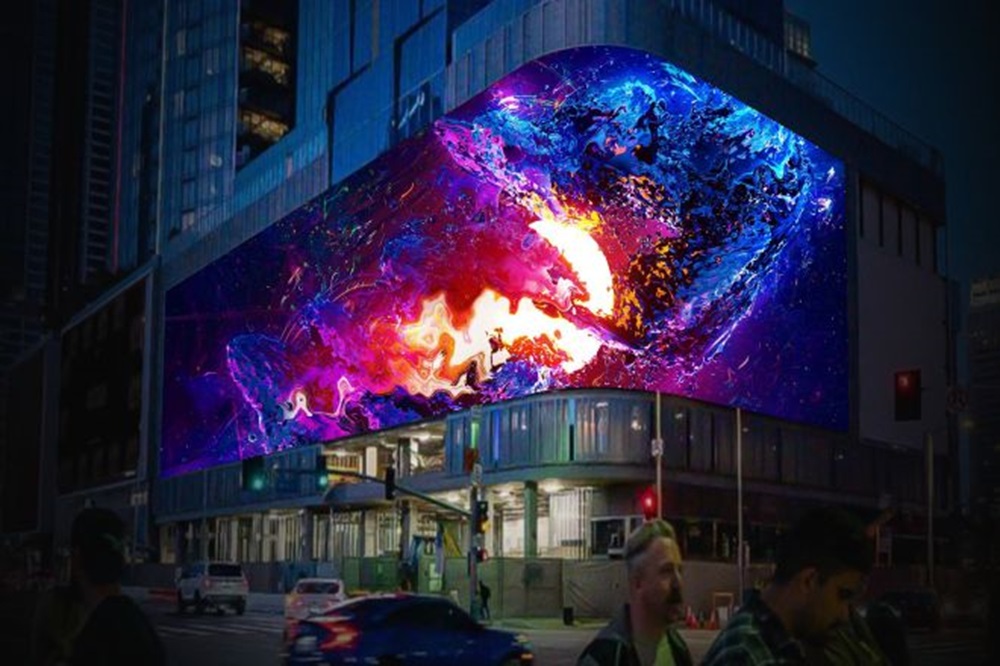In today’s digital era, LED display applications have expanded far beyond traditional flat screens. From curved and spherical displays to interactive tunnels and transparent panels, LED technology is reshaping the way businesses, venues, and public spaces deliver visual experiences. This article explores the most innovative LED display applications, showcasing their unique features, benefits, and real-world examples.
Curved LED Displays
Curved LED displays, also called flexible or bendable LED screens, combine traditional LED technology with bending techniques. These displays can be shaped at different angles, creating innovative and eye-catching effects. They are widely used in commercial advertising, interior and exterior decoration, and are perfect for achieving the popular naked-eye 3D effect.
Corner LED Displays
Also known as right-angle screens, corner LED displays create three-dimensional visuals by combining two walls. This design delivers immersive naked-eye 3D effects, often applied in building facades and interior corners. A striking example is the massive LED corner screen at the Meizu flagship store in Wuhan, which delivers highly realistic 3D visuals.
Spherical LED Displays
Spherical LED screens provide a 360° viewing experience, ensuring content can be seen clearly from any angle. A world-famous example is the MSG Sphere, a massive spherical LED screen that hosts concerts, films, and sports events. This represents one of the most impressive LED display applications for large-scale entertainment.
LED Splicing Screens
Splicing LED screens are built with multiple modules, unrestricted by size. With high resolution, contrast, and vivid colors, they are widely used in control centers, offices, showrooms, and malls. Their versatility makes them one of the most common LED display applications in professional and commercial environments.
LED Cube Displays
LED cube displays feature six panels forming a 3D cube, offering seamless viewing from every angle. They are popular in shopping malls and retail stores, where they serve as powerful tools for advertising, promotions, and brand storytelling. Their artistic and futuristic design attracts high customer engagement.
LED Tunnel Displays
LED tunnel screens create immersive passageways using seamless LED modules. Combined with multimedia content, they provide visitors with dynamic transitions, such as seasonal changes or historical themes. For instance, the Taohuayuan Scenic Area in Hunan uses a 150-meter LED tunnel that allows visitors to experience a journey through time.
LED Floor Displays
LED floor screens are specially designed for interactive experiences. With strong load-bearing and heat dissipation, they react to foot movements, making them popular in entertainment venues like bars, museums, wedding halls, and large-scale performances. This interactive technology is among the most engaging LED display applications.
LED Strip Displays
Also known as light bar screens, LED strip displays are composed of bar-shaped diodes that can display animations, text, and visuals. For example, LED staircase screens provide smooth and layered transitions, offering unique architectural and entertainment effects.
LED Tree Displays
Tree-shaped LED displays blend sound, light, and visuals, delivering artistic and immersive experiences. At the Qingdao MGM Hotel, an LED tree screen connects spaces with vivid visuals, offering guests a unique and memorable experience.
LED Sky Screens
Installed on ceilings or semi-enclosed areas, LED sky screens create decorative and immersive environments. At Phoenix Maglev High-Speed Railway Station, a massive LED sky screen was introduced to enhance digital upgrades, improving both visual impact and passenger experience.
Transparent LED Displays
Transparent LED screens are thin, lightweight, and visually striking. They are ideal for glass curtain walls, shop displays, and exhibitions. Their transparency creates a floating 3D effect, merging real-world backgrounds with digital visuals, making them one of the most innovative LED display applications in modern architecture.
Interactive LED Displays
Interactive LED screens respond to user movements, creating immersive experiences. They can display flowers, vines, or rhythmic animations that change with audience interaction. This dynamic form of engagement transforms static visuals into exciting and memorable experiences.
Conclusion
From curved and spherical displays to interactive floors, tunnels, and transparent panels, LED display applications continue to redefine how we experience visuals in both public and commercial spaces. With endless possibilities in creativity and innovation, LED displays are not only tools for communication but also powerful platforms for storytelling, branding, and audience engagement.
Post time: Aug-18-2025

